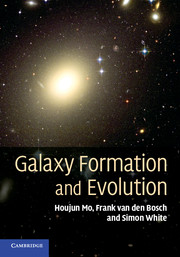Book contents
- Frontmatter
- Contents
- Preface
- 1 Introduction
- 2 Observational Facts
- 3 Cosmological Background
- 4 Cosmological Perturbations
- 5 Gravitational Collapse and Collisionless Dynamics
- 6 Probing the Cosmic Density Field
- 7 Formation and Structure of Dark Matter Halos
- 8 Formation and Evolution of Gaseous Halos
- 9 Star Formation in Galaxies
- 10 Stellar Populations and Chemical Evolution
- 11 Disk Galaxies
- 12 Galaxy Interactions and Transformations
- 13 Elliptical Galaxies
- 14 Active Galaxies
- 15 Statistical Properties of the Galaxy Population
- 16 The Intergalactic Medium
- A Basics of General Relativity
- B Gas and Radiative Processes
- C Numerical Simulations
- D Frequently Used Abbreviations
- E Useful Numbers
- References
- Index
5 - Gravitational Collapse and Collisionless Dynamics
Published online by Cambridge University Press: 05 June 2012
- Frontmatter
- Contents
- Preface
- 1 Introduction
- 2 Observational Facts
- 3 Cosmological Background
- 4 Cosmological Perturbations
- 5 Gravitational Collapse and Collisionless Dynamics
- 6 Probing the Cosmic Density Field
- 7 Formation and Structure of Dark Matter Halos
- 8 Formation and Evolution of Gaseous Halos
- 9 Star Formation in Galaxies
- 10 Stellar Populations and Chemical Evolution
- 11 Disk Galaxies
- 12 Galaxy Interactions and Transformations
- 13 Elliptical Galaxies
- 14 Active Galaxies
- 15 Statistical Properties of the Galaxy Population
- 16 The Intergalactic Medium
- A Basics of General Relativity
- B Gas and Radiative Processes
- C Numerical Simulations
- D Frequently Used Abbreviations
- E Useful Numbers
- References
- Index
Summary
Many objects in the present-day Universe, including galaxies and clusters of galaxies, have densities orders of magnitude higher than the average density of the Universe. These objects are thus in the highly nonlinear regime, where δ»1. To complete our description of structure formation in the Universe, we therefore need to go beyond perturbation growth in the linear and quasi-linear regimes, discussed in the previous chapter, and address the gravitational collapse of overdensities in the nonlinear regime.
In this chapter, we study the nonlinear gravitational collapse and dynamics of collisionless systems in which non-gravitational effects are negligible. In general, nonlinear gravitational dynamics is difficult to deal with analytically, and so in many applications computer simulations have to be used to follow the evolution in detail. However, if simple assumptions are made about the symmetry of the system, analytical models can still be constructed (§§5.1- 5.3). Although these models are not expected to give accurate descriptions of the true nonlinear problem of gravitational collapse, they provide valuable insight into the complex processes involved. In §5.4 we describe the dynamics of collisionless equilibrium systems. These dynamical models describe the end states of the nonlinear gravitational collapse of a collisionless system, and are applicable to both galaxies and dark matter halos in a steady state. As such, these models are often used to model the observed kinematics of galaxies in an attempt to constrain their masses and their orbital structures.
- Type
- Chapter
- Information
- Galaxy Formation and Evolution , pp. 215 - 261Publisher: Cambridge University PressPrint publication year: 2010

